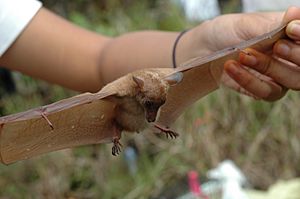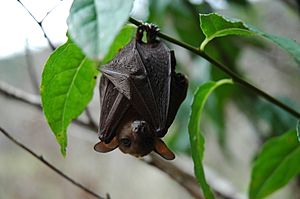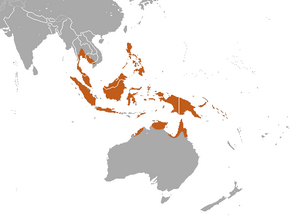Long-tongued nectar bat facts for kids
Quick facts for kids Long-tongued nectar bat |
|
|---|---|
 |
|
| Pregnant individual in the Philippines | |
 |
|
| in the Philippines | |
| Conservation status | |
| Scientific classification | |
| Genus: |
Macroglossus
|
| Species: |
minimus
|
 |
|
| Geographic range of M. minimus | |
The long-tongued nectar bat (Macroglossus minimus), also known as the northern blossom bat or honey nectar bat, is a type of megabat. Megabats are generally larger bats that often eat fruit or nectar. This bat is one of the smallest megabats, usually 60 to 85 millimeters long. That's about the length of your finger! It has reddish-brown fur, which is quite long. Its belly fur is lighter, and a dark brown stripe runs down its head and back.
Where They Live
These bats live in many places across Asia and Australia. You can find them in countries like Thailand, Malaysia, the southern Philippines, Indonesia (like Java and Borneo), New Guinea, the Solomon Islands, and northern Australia.
Scientists have not found these bats living in large groups. This suggests they might live alone or in very small groups. They eat nectar and pollen from flowers, especially from mangrove trees and banana flowers. The long-tongued nectar bat is very important for nature because it helps many trees by moving pollen from one flower to another. This process is called pollination. They help plants like those found in mangrove forests and other types of forests. These bats can be found from sea level up to mountains that are 1000 meters high.
Life Cycle and Growth
When scientists study these bats, they usually find a similar number of males and females. Most of the bats they observe are adults.
Female long-tongued nectar bats are pregnant for about 120 days. After the babies are born, the mothers feed them milk for 60 to 70 days. In some areas, like Negros Island in the Philippines, females can have two or three babies each year. These bats can have babies at any time of the year, especially when there is a lot of food available.
How They Grow
Young bats grow very quickly. Their forearm (part of their wing) grows about 0.24 millimeters every day. They also gain about 0.07 grams of weight daily. A young bat that is ready to fly on its own will have a forearm about 35 millimeters long and weigh around 9 grams. Adult bats are 60 to 85 millimeters long from head to body. Their head is about 26 to 28 millimeters long. Their forearm is 40 to 43 millimeters long, and they weigh between 12 and 18 grams. This bat is smaller and lighter than its close relative, the Macroglossus sobrinus.
See also
 In Spanish: Macroglossus minimus para niños
In Spanish: Macroglossus minimus para niños


